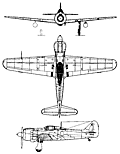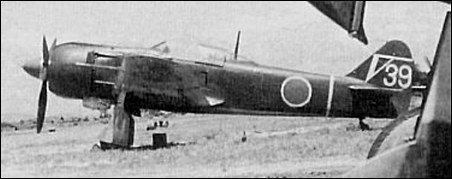|
| The Kawasaki Ki-61-II with the company's
Ha-140 engine was seen as an
interim high-altitude interceptor to
tackle the USAF's Boeing B-29s at their
cruising altitude of some 9000m. However, development of
the Ha-140 as a reliable powerplant
was terminated finally when the
Akashi factory where the engine was
built was destroyed during an air raid.
With the requirement becoming daily
more urgent, Kawasaki was instructed
to convert the 275 Ki-61-II airframes
gathering dust in the Kagamigahara
factory with alternative powerplant.
No other similar engine was available
and adaptation of the slender fuselage
of the Ki-61 to allow installation of a
large-diameter radial engine at first
appeared impractical. However,
Kawasaki's design team converted
three airframes to serve as prototypes,
installing a Mitsubishi Ha-112-II engine
which had the same power output as
the unreliable Ha-140. When the first of
these was flown, on 1 February 1945,
Kawasaki discovered that it had a first class
fighter, one that some commentators
have described as Japan's premier
fighter aircraft of the Pacific war.
By the end of May 1945 all of the remaining
272 Ki-61 airframes had been
converted to the new configuration,
entering service as the Army Type 5
Fighter Model 1A, which was identified
by the company as the Kawasaki
Ki-100-Ia.
With the Ki-100 proving such a success,
it was decided to initiate production
of this aircraft, the resulting Ki-100-Ib differing only by having the cutdown
rear fuselage and all-round-view
canopy that had been designed for the
proposed Ki-61-III. A total of 99 of this
version was built before production
was brought to an end by the growing
weight of USAAF air attacks. A more
effective version had been planned, to
be powered by the Mitsubishi Ha-112-
Ilru engine which incorporated a turbocharger
to improve high-altitude
performance, but only three of these
Ki-100-II prototypes had been built
and flown by the end of the war.

| MODEL | Ki-100-I |
| CREW | 1 |
| ENGINE | 2 x Mitsubishi Ha-112-II, 1125kW |
| WEIGHTS |
| Take-off weight | 3495 kg | 7705 lb |
| Empty weight | 2525 kg | 5567 lb |
| DIMENSIONS |
| Wingspan | 12 m | 39 ft 4 in |
| Length | 8.82 m | 29 ft 11 in |
| Height | 3.75 m | 12 ft 4 in |
| Wing area | 20 m2 | 215.28 sq ft |
| PERFORMANCE |
| Max. speed | 580 km/h | 360 mph |
| Cruise speed | 400 km/h | 249 mph |
| Ceiling | 11000 m | 36100 ft |
| Range w/max.fuel | 2200 km | 1367 miles |
| Range w/max payload | 1400 km | 870 miles |
| ARMAMENT | 2 x 20mm cannons, 2 x 12.7mm machine-guns |
 | A three-view drawing (752 x 963) |
| Ron, e-mail, 16.12.2010 07:10 The enlarged tail and horizontal stabilizer of the Ki 61-II Kai immediately transformed it's flight characteristics vs the earlier Ki 61-II; and the Ki 61 wing profile was better than that of the Ki 84 at higher speeds as in diving maneuvers and handling (to amend my last post).
The Ki 100 was the beneficiary. 'Maximum permissible diving speed' was 528 mph for the Ki 100 and it held it's speed after pull out! That's probably faster than any Japanese fighter but the Ki 61.
Up to 23,000' it was superb and potentially the master of all opposing fighters except the P-51D which made a good 'ferocious' fight depending on pilot skill for the outcome. But at higher altitudes performance fell rapidly.
It's life span was short and sweet: 10 months from conception to surrender. reply | | Ron, e-mail, 29.11.2010 23:00 Some say the straight leading edge of the Nakajima wing was not as good as the Kawasaki wing for handling in aerobatics.
The Ki 100 was also said to have good power of maneuver. reply | | Ron, e-mail, 25.11.2010 00:11 I found out that handling was sweeter because the fuel tank was moved from behind to in front of the pilot when the radial replaced the inline on the Tony. Evidently the change in cg was favorable. If it utilized a wing of increased area as some say, that would enhance handling directly.
Wikipedia has the comment about the edge the Ki 100 had over the Ki 84 in a dogfight in the opinion of their test pilots. If the Hayabusa was a handful to trim ...etc compared to the Reisen, perhaps the Hayate was even more labor intensive with the tempermental engine vs the Goshikisen pilot's plane. Reminds me of the torquey Spitfire Mk XIV vs the Mk VIII favorite. reply | | Raheel Iqbal, e-mail, 08.10.2010 13:49 its nicce effort of kawasaki caompani this company givs tha mechnical technologi a new horizon of envention i like its technology i m from paksitan as tha every one man know tha pakistan is devolped contry and there we used kawasaki technology but there is no your industriy i wana worke in your high level industry with your brilent engineer reply | |
| | Aaron, e-mail, 23.09.2010 08:33 Ron,
I used to believe a radial engine aircraft improved roll also. But then there seemed like there was one exception to the rule .......P-36 /P-40. At speed the P-40's roll continued to increase where the P-36's fell off. Aircraft design is the key. Lord, I would really like to see some
test figures on actual roll rates of the Ki.100. From what I have read to date, roll rate, acceleration and high altitude performance are what set this Kawasaki apart from the other Japanese fighters. reply | | Aaron, e-mail, 13.08.2010 08:26 The ki.100 was a nasty suprise to the us. It was an awsome plane in its own right but the King and Queen of the Pacific were the F4U-4 and P-38L. Go check out there real limitations that I have discussed on this sight. reply | | Ron, e-mail, 06.09.2010 09:20 Leo,
Mostly tuning. The Ha-40 and 140 were lighter than their German cousins which had tight tolerances and these lighter versions had even more precise tolerances still. So factory worker skill was at a premium.
Another thing is the quality of the fuel in the field.
Also there is the experience of the Japanese mechanics on inline motors vs German experience.
If tuning wasn't right, it could suddenly lose power. reply | | Ronald, e-mail, 09.09.2009 09:12 In mock dogfights between equally skilled Japanese pilots pitting the Ki 100 Goshikisen against the Ki 84 Hayate, the Ki 100 always won. Every time! Hard to see how unless you witnessed it. The Ki 84 had the level speed advantage but it was over 40 mph slower in dive speed. Granted, the Hayate could outperform the latest U.S. fighters at medium altitudes and even out-turn the Spitfire. But the radial Tony was no Spitfire. It was somehow a superior adversary (except way up high). Add to that the fact that it had a tougher hide to absorb combat damage and was more reliably powered than the Nakajima uber fighter, perhaps the Kawasaki pilot's enthusiasm can be better appreciated. Inline Tonys have been said to out-roll (at least to the left) the U.S. Navy fighters, so maybe the radial improves roll, it should (ala Fw 190A radial vs Fw 190D inline). The right turn in the earlier Ki 61 Tony was much inferior to the left turn, maybe the Ki 100's radial helped with this flaw too. What's left? All we know for sure is the weight of the vulnerable liquid cooling required for the inline engine wasn't missed. Now it was lighter on it's feet. reply | | Ronald, e-mail, 17.06.2009 07:34 If it came out of a high speed dive it was fast. The Kawasakis were the only Japanese fighters that could hope to dive with the Mustangs. Otherwise it's true that level speed was inferior to it's fore-bear, the Ki 61-II Tony (if it was well tuned). But the Ki 100 Tony dropped the weight of the liquid cooling on the inline engine, improving it's handling. The less vulnerable radial was more reliable than other late model Japanese radial fighters like the Jack, George, and Frank. Also much sturdier than the Tojo or slower late model Oscar and Zero. At a time when Japan's young fliers had abbreviated training, such a more simple 'pilot's plane' was made to order. It proved itself a success against U.S. raiders (especially the Hellcat) out of all proportion to it's numbers at the end of the war. Maybe best isn't the word. Surprisingly effective might be the right phrase. On paper it doesn't shine, but in the air is where it counts. reply | | Leo Rudnicki, e-mail, 02.06.2009 17:46 The fastest Japanese Army fighter was the Frank, when running good. The most often called best fighter was George II, the best B-29 intercepter was Shoki, the most serendipitous mongrel hybrid was, in fact, the KI-100. At one time, the hottest fighter was the KI-61. Pappy said so. Question: what was the nature of the problem in manufacturing DB engines in the first place? I have never even heard any half-decent conjecture. reply | | gen.Tacticus, e-mail, 02.06.2009 13:05 Why was it called "best Japanese fighter of WW2?"
Speed isn't exactly impressive - Ki84 is faster, maybe also N1K2-J. Is it turning radius? High-altitude performance? Thrust-to-weight? reply | | Mick Dunne, e-mail, 23.11.2008 08:36 Woah Mr Wolf! The engine that transformed the Ki61 into the world beating Ki100 was a Bomber engine!...the Mitsubishi Ha 112! The Homare was nowhere near as reliable and not considered for use in the Kawasaki fighter. But it is easy to see how you got them confused...we all do! reply | | m.wolf, e-mail, 20.03.2008 18:38 It truly was an amazing feat of engineering that Imperial Japan could develop such a fine fighting machine at this stage of the war. She was deployed in February of 1945 at a time when Japanese industry and cities were being pummelled unmercifully by Curtis Lemays B-29 bombers. Joining a Mitsubishi Homare 112 engine with a Kawasaki KI-61 airframe was done by studying blue prints of the Yokasuka D4Y1 torpedoe plane and having help also from the Focke- Wulf staff who married a BMW 801 engine with a slim airframe and developed another fine fighting machine. The Kawasaki KI-100 was truly an outstanding fighter for its time and the pilots praised how easy it was to fly. reply | | Cardinal Sin, 21.02.2008 02:59 Propably the best japanese fighter of WW2 reply |
|
Do you have any comments?
|
| 
COMPANY
PROFILE
All the World's Rotorcraft
|








